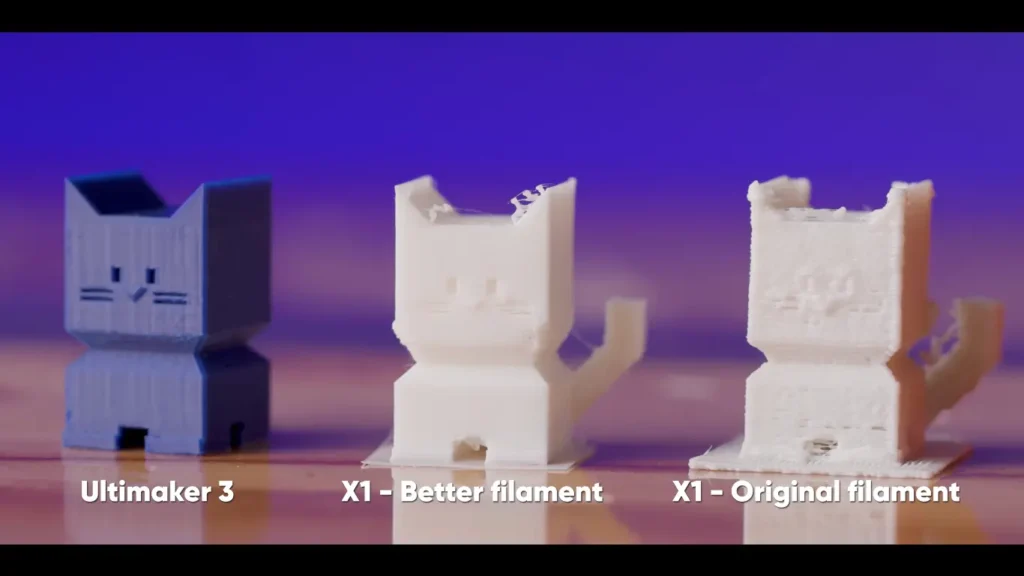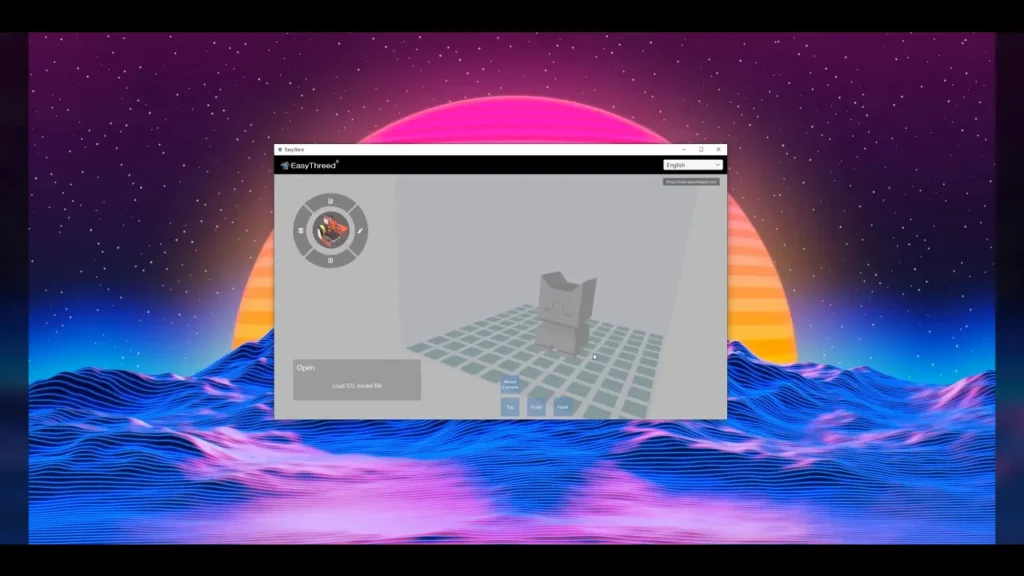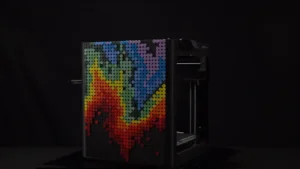If you’re looking for an affordable entry into the world of 3D printing, the Easythreed X1 FDM Mini 3D printer might be the Perfect choice. With a variety of features, this affordable 3D printer under $100 is a great choice for educators, hobbyists & anybody else curious in 3D printing.
Key Features and Functionalities
The Easythreed X1 FDM Mini 3D printer utilizes Fused Deposition Modeling (FDM) technology, which is one of the most popular and accessible 3D printing methods. It is perfect for printing tiny to medium-sized things because of its compact build volume of 100x100x100mm. The printer features a 0.4mm nozzle diameter, allowing for a print resolution between 0.05mm and 0.4mm, suitable for creating detailed models & prototypes.
One of the standout features of this 3D printer under $100 is its compatibility with various filament types, including PLA & wood filaments. Additionally, it supports USB & TF card connectivity, allowing you to transfer and print your 3D models directly from external storage devices.

Pros and Cons
Pros:
- Affordable price point: At under $100, the Easythreed X1 FDM Mini 3D printer offers an accessible entry into the world of 3D printing.
- User-friendly operation: With a simple 4-button control panel, this 3D printer under $100 is easy to navigate and operate, making it suitable for beginners.
- Compact size: The small footprint of the printer makes it convenient to set up and use in limited spaces, such as desktops or workbenches.
- Fast heating: The printer’s nozzle can reach temperatures up to 230°C in just 5 minutes, allowing for quick printing sessions.
Cons:
- Limited build volume: While the 100x100x100mm build area is sufficient for small to medium-sized projects, it may not be suitable for larger or more complex models.
- No automatic bed leveling: Manual bed leveling is required, which can be a bit challenging for beginners and may impact print quality if not done correctly.
- Lack of advanced features: This budget 3D printer under $100 lacks some advanced features found in higher-end models, such as Wi-Fi connectivity, a heated print bed, or an enclosed printing chamber.
- Potential for quality issues: As with any budget 3D printer, there may be inconsistencies in print quality or reliability compared to more expensive models.
Target Audience and Applications

The Easythreed X1 FDM Mini 3D printer under $100 is an excellent choice for a wide range of users, including hobbyists, educators, makers, designers, entrepreneurs and anyone interested in exploring rapid prototyping & custom object creation.
For hobbyists & makers, this budget 3D printer opens up a world of possibilities, allowing them to bring their creative ideas to life by producing unique accessories, figurines or custom parts. Designers and entrepreneurs can leverage the Easythreed X1 for rapid prototyping, testing out new product concepts and creating functional prototypes before committing to larger-scale production.
In the educational sector, this affordable 3D printer under $100 serves as an invaluable tool for introducing students to the fundamentals of 3D printing, design thinking & engineering principles. Teachers can use it to create engaging educational models, visual aids and hands on projects that foster creativity & problem solving skills.
Furthermore, the Easythreed X1 FDM Mini 3D printer can benefit artists & crafters who wish to produce unique and personalized creations, such as jewelry, home decor items, or artistic sculptures. Its compact size & user friendly interface make it accessible to a wide range of users, regardless of their technical expertise.
With its versatility & affordability, the Easythreed X1 FDM Mini 3D printer under $100 caters to a diverse audience, empowering individuals to explore the world of 3D printing, unleash their creativity and bring their ideas to tangible form.

Unique Features
While the Easythreed X1 FDM Mini 3D printer may lack some advanced features found in higher-end models, it does offer a few unique advantages for a 3D printer under $100:
- Dual cooling fans: The printer features dual fans for better heat dissipation, ensuring faster & more even modeling.
- All-metal nozzle: The printer uses a professional all-metal nozzle, which minimizes the risk of printing errors and ensures consistent print quality.
Software Compatibility and Connectivity
The Easythreed X1 FDM Mini 3D printer supports a variety of slicing software options, including Easyware, Cura, and Simplify3D. These software programs allow you to convert 3D models into printable G-code files that the printer can understand.

In terms of connectivity, the printer supports USB and TF card input, allowing you to transfer and print your 3D models directly from external storage devices. However, it does not offer Wi-Fi connectivity, which may be a drawback for some users.
Conclusion
The Easythreed X1 FDM Mini 3D printer is an excellent choice for anyone wishing to start into 3D printing on a budget. While it may lack some advanced features found in higher-end models, this 3D printer under $100 offers a user-friendly experience, decent print quality, and compatibility with various filament types.
Whether you’re a hobbyist, educator or entrepreneur, the Easythreed X1 FDM Mini 3D printer can be a valuable tool for creating small to medium-sized prototypes, figurines, architectural models & educational models. With its compact size, easy operation & affordable price point, this 3D printer under $100 is an excellent starting point for those interested in exploring the exciting 3D printing world.
Comparison with Creality Ender 3 3D Printer
When exploring budget-friendly 3D printers, the Creality Ender 3 is often considered a strong contender alongside the EasyThreed X1. While both printers offer an affordable entry point into 3D printing, there are some notable differences:

- Build Volume: The Creality Ender 3 boasts a larger build volume of 220 x 220 x 250 mm, compared to the X1’s 100 x 100 x 100 mm, allowing for larger and more complex prints.
- Print Quality: While the X1 delivers impressive print quality for its price range, the Ender 3 is generally considered to produce higher-quality prints with better surface finishes.
- Automatic Bed Leveling: The Ender 3 offers the option for automatic bed leveling (with additional accessories), which can simplify the leveling process and improve print consistency.
- Filament Compatibility: The Ender 3 is compatible with a wider range of filament materials, including more advanced options like ABS and PETG, providing greater versatility.
- Community Support: The Ender 3 has a larger user community, offering more resources, upgrades, and troubleshooting support.
- Price: The Creality Ender 3 is typically priced slightly higher than the X1, but still remains an affordable option for many users.
EasyThreed X1 Vs Creality Ender 3 spec chart:
| Specification | EasyThreed X1 | Creality Ender 3 |
|---|---|---|
| Build Volume | 100 x 100 x 100 mm | 220 x 220 x 250 mm |
| Print Technology | FDM | FDM |
| Nozzle Diameter | 0.4 mm | 0.4 mm (default) |
| Layer Resolution | 0.05 – 0.4 mm | 0.1 – 0.4 mm |
| Heated Bed | Yes | Yes |
| Auto Bed Leveling | No | No (upgradable) |
| Print Speed | 10 – 40 mm/s | 180 mm/s (max) |
| Filament Diameter | 1.75 mm | 1.75 mm |
| Connectivity | TF Card, USB | SD Card, USB |
| Supported Materials | PLA, Wood | PLA, ABS, TPU, etc. |
| Resume Printing Function | No | Yes |
| Price | $89.99 | $189 (Official Site), $169 (Amazon) |
As you can see, while the EasyThreed X1 is significantly more affordable, the Creality Ender 3 offers a larger build volume, higher maximum print speed, compatibility with a wider range of materials, and the ability to resume printing after power outages or interruptions. However, the X1 still provides a decent entry level option for those on a tight budget.
My Opinion
If you can afford to spend a little more than $100, the Creality Ender 3 3D Printer can be a great option. While the EasyThreed X1 is an excellent choice for those on a tight budget and looking to try out 3D printing, the Ender 3 offers several advantages that may justify the slightly higher cost.
With its larger build volume, superior print quality & broader material compatibility, the Ender 3 provides more flexibility and room for growth as you gain experience and take on more ambitious projects. Additionally, the availability of automatic bed leveling and a vast user community can make the learning curve smoother and provide access to a wealth of resources and upgrades.
Still, it’s Important to remember that the X1 offers an impressive value proposition for its price range, which makes it a great place to start for beginners & those on a limited budget. Ultimately, your decision should be based on your specific needs, budget & willingness to invest in a more capable machine from the outset.
:FAQs:
How do I level the print bed on the Easythreed X1 FDM Mini 3D printer?
Leveling the print bed is a crucial step for ensuring successful prints. Follow the included manual or watch online tutorials to learn the proper leveling procedure. It typically involves adjusting the bed screws until the nozzle is at the correct distance from the bed surface.
What types of filaments can I use with this 3D printer under $100?
The Easythreed X1 FDM Mini 3D printer is compatible with PLA and wood filaments out of the box. However, it may be possible to use other filament types with proper temperature and settings adjustments.
How do I troubleshoot common printing issues?
Common printing issues can include poor bed adhesion, stringing, warping, or layer shifting. Refer to the printer’s manual or online resources for troubleshooting tips and solutions. Adjusting settings like bed temperature, nozzle temperature & printing speed can often resolve many issues.
Can I use larger spools of filament with this 3D printer under $100?
While the Easythreed X1 FDM Mini 3D printer comes with a spool holder, it may not be suitable for larger spools. You may need to look at different spool holder options or create a custom holder to accept larger filament spools.
What is the recommended print speed for this 3D printer under $100?
The Easythreed X1 FDM Mini 3D printer has a recommended print speed range of 10-40mm/s. However, you may need to experiment to find the optimal print speed for your specific models and filament types.
Nikko Jenkins is a technology journalist based in the US, covering tool reviews and comparisons across North America, Europe and Asia, particularly 3D Printers. His concise, insightful articles on the latest innovations help readers worldwide make informed tech decisions. Jenkins’ expertise and engaging style have made him a respected voice in the global technology landscape.
Feel free to reach out to me at nikkojenkins@360techinsights.com.




